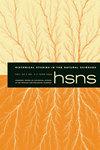A Black Hole in Ink
IF 0.3
3区 哲学
Q2 HISTORY & PHILOSOPHY OF SCIENCE
引用次数: 0
Abstract
Half a century before black hole images based on observations were released, physicists used calculations and simulations to depict what they thought the surroundings of black holes would look like. We focus in particular on the framing and reception of a 1978 image by French astrophysicist Jean-Pierre Luminet. This handmade drawing was described as “realistic” even though black hole shadows had not yet been observed. Using his image to convince astronomers of the existence of black holes, Luminet argued for the accuracy of his image by emphasizing the physical effects taken into account in the simulation he used for his drawing and made references to photography in descriptions of it. At the same time, he presented the appearance of light near a black hole, as seen by a distant observer, as “optical distortions.” Like Nobel Laureate Roger Penrose, Luminet was a creator of images used in General Relativity who had found inspiration in Dutch artist M. C. Escher’s work. But unlike the plays on perspective that Escher was known for, black hole images were not used to confound the beholder or to make the beholder aware of their role as an interpreter of contradictory images. Luminet instead used apparent “optical distortions” to further intuition about black holes. Focusing on what light near a black hole looked like, Luminet explained why his image looked the way it did to communicate the nature of what was invisible.墨水中的黑洞
在基于观测的黑洞图像发布的半个世纪之前,物理学家使用计算和模拟来描绘他们认为黑洞周围的样子。我们特别关注法国天体物理学家让-皮埃尔·卢米内1978年拍摄的图像的构图和接收。这幅手工绘制的图被描述为“逼真的”,尽管黑洞的阴影尚未被观察到。卢米内特用他的图像说服天文学家相信黑洞的存在,他强调了他的图像的准确性,强调了他用于绘图的模拟中考虑到的物理效应,并在描述时参考了摄影。与此同时,他提出了黑洞附近的光的外观,正如远处的观察者所看到的那样,是“光学扭曲”。与诺贝尔奖得主罗杰·彭罗斯(Roger Penrose)一样,卢米内特也是广义相对论中所用图像的创造者,他从荷兰艺术家m·c·埃舍尔(M. C. Escher)的作品中找到了灵感。但与埃舍尔著名的透视剧不同的是,黑洞图像并不是用来迷惑观察者或让观察者意识到他们作为矛盾图像的解释者的角色。Luminet转而使用明显的“光学扭曲”来进一步了解黑洞。Luminet专注于黑洞附近的光线是什么样子的,他解释了为什么他的图像看起来是这样的,以传达不可见的本质。
本文章由计算机程序翻译,如有差异,请以英文原文为准。
求助全文
约1分钟内获得全文
求助全文
来源期刊

Historical Studies in the Natural Sciences
社会科学-科学史与科学哲学
CiteScore
1.00
自引率
0.00%
发文量
24
审稿时长
>12 weeks
期刊介绍:
Explore the fascinating world of Historical Studies in the Natural Sciences, a journal that reveals the history of science as it has developed since the 18th century. HSNS offers in-depth articles on a wide range of scientific fields, their social and cultural histories and supporting institutions, including astronomy, geology, physics, genetics, natural history, chemistry, meteorology, and molecular biology. Widely regarded as a leading journal in the historiography of science and technology, HSNS increased its publication to five times per year in 2012 to expand its roster of pioneering articles and notable reviews by the most influential writers in the field.
 求助内容:
求助内容: 应助结果提醒方式:
应助结果提醒方式:


